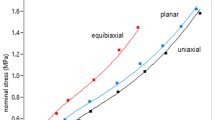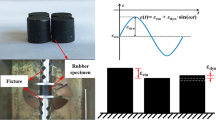Abstract
Two factors which affect the creep and stress relaxation of rubbers at room temperature are discussed.
The rate of relaxation in filled rubbers is dependent on the previous mechanical history of the specimen. Pre-stressing a rubber reduces the subsequent relaxation rate and this reduction is for most purposes permanent. Recovery can, however, be induced by swelling and deswelling the specimen.
A rise in temperature during a relaxation experiment is accompanied by a marked, short term, acceleration of the relaxation. The creep which this produces is not recovered when the temperature is reduced to its original level. The magnitude of the extra relaxation from this effect is greatest if the cycle occurs in the early stages of relaxation and also greatest during the first such cycle.
Both the effects are of importance in any consideration of the molecular nature of relaxation, and indicate that a simple network theory of viscoelasticity is inadequate. The effects are also of practical significance in that both of these factors should be well understood if laboratory testing is to be used for predicting the service behaviour of rubber components.
Similar content being viewed by others
Abbreviations
- CBS:
-
N-cyclohexyl-benzthiazole-2-sulphenamide
- Nonox D:
-
phenyl-β-naphthylamine
- Nonox ZA:
-
4-isopropylamino diphenyl-amine
- Nonox HFN:
-
arylamine blend
References
A. N. Gent, “Relaxation processes in vulcanized rubber,”J. Appl. Polymer. Sci. 6 (1962) 22, 433.
C. J. Derham, Proceedings International Rubber Conference, Brighton (1972) F1.1.
C. J. Derham, E. Southern, andA. G. Thomas,Proc. Intl. Rubb. Conf. Moscow (1969); reprinted in NRPRA NR Technology Part 2 (1970).
L. Mullins andN. R. Tobin,Proc. 3rd. Rubb. Technol. Conf., London (1954) 397.
E. H. Andrews,Rubb. Chem. and Tech. 36 (1963) 325.
C. J. Derham, unpublished work.
C. J. Derham andP. B. Lindley, Proc. 5th Intl. conf. on Fluid Sealing. (British Hydromechanic Research Association, Coventry, 1971) C1.1.
C. J. Derham andA. G. Thomas,Nature (Lond.) 218 (1968) 81.
J. A. C. Harwood, L. Mullins, andA. R. Payne,J. Inst. Rubb. Ind. 1 (1967) 17.
Author information
Authors and Affiliations
Rights and permissions
About this article
Cite this article
Derham, C.J. Creep and stress relaxation of rubbers—the effects of stress history and temperature changes. J Mater Sci 8, 1023–1029 (1973). https://doi.org/10.1007/BF00756634
Received:
Accepted:
Issue Date:
DOI: https://doi.org/10.1007/BF00756634




